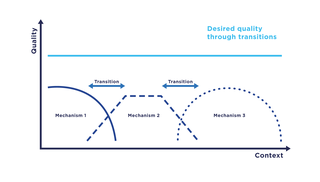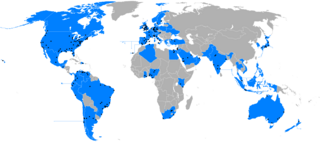Related Research Articles

In programming and software development, fuzzing or fuzz testing is an automated software testing technique that involves providing invalid, unexpected, or random data as inputs to a computer program. The program is then monitored for exceptions such as crashes, failing built-in code assertions, or potential memory leaks. Typically, fuzzers are used to test programs that take structured inputs. This structure is specified, e.g., in a file format or protocol and distinguishes valid from invalid input. An effective fuzzer generates semi-valid inputs that are "valid enough" in that they are not directly rejected by the parser, but do create unexpected behaviors deeper in the program and are "invalid enough" to expose corner cases that have not been properly dealt with.
Software visualization or software visualisation refers to the visualization of information of and related to software systems—either the architecture of its source code or metrics of their runtime behavior—and their development process by means of static, interactive or animated 2-D or 3-D visual representations of their structure, execution, behavior, and evolution.

The International Symposium on Computer Architecture (ISCA) is an annual academic conference on computer architecture, generally viewed as the top-tier in the field. Association for Computing Machinery's Special Interest Group on Computer Architecture and Institute of Electrical and Electronics Engineers Computer Society are technical sponsors.

ProVerif is a software tool for automated reasoning about the security properties found in cryptographic protocols. The tool has been developed by Bruno Blanchet.

Evercookie is a JavaScript application programming interface (API) that identifies and reproduces intentionally deleted cookies on the clients' browser storage. It was created by Samy Kamkar in 2010 to demonstrate the possible infiltration from the websites that use respawning. Websites that have adopted this mechanism can identify users even if they attempt to delete the previously stored cookies.

ArpON is a computer software project to improve network security. It has attracted interest among network managers and academic researchers and is frequently cited as a means of protecting against ARP-based attacks.
Intel Software Guard Extensions (SGX) is a set of instruction codes implementing trusted execution environment that are built into some Intel central processing units (CPUs). They allow user-level and operating system code to define protected private regions of memory, called enclaves. SGX is designed to be useful for implementing secure remote computation, secure web browsing, and digital rights management (DRM). Other applications include concealment of proprietary algorithms and of encryption keys.

American fuzzy lop (AFL), stylized in lowercase as american fuzzy lop, is a free software fuzzer that employs genetic algorithms in order to efficiently increase code coverage of the test cases. So far it has detected dozens of significant software bugs in major free software projects, including X.Org Server, PHP, OpenSSL, pngcrush, bash, Firefox, BIND, Qt, and SQLite.
RIPE Atlas is a global, open, distributed Internet measurement platform, consisting of thousands of measurement devices that measure Internet connectivity in real time.
Implicit authentication (IA) is a technique that allows the smart device to recognize its owner by being acquainted with his/her behaviors. It is a technique that uses machine learning algorithms to learn user behavior through various sensors on the smart devices and achieve user identification. Most of the current authentication techniques, e.g., password, pattern lock, finger print and iris recognition, are explicit authentication which require user input. Comparing with explicit authentication, IA is transparent to users during the usage, and it significantly increases the usability by reducing time users spending on login, in which users find it more annoying than lack of cellular coverage.
Cache prefetching is a technique used by computer processors to boost execution performance by fetching instructions or data from their original storage in slower memory to a faster local memory before it is actually needed. Most modern computer processors have fast and local cache memory in which prefetched data is held until it is required. The source for the prefetch operation is usually main memory. Because of their design, accessing cache memories is typically much faster than accessing main memory, so prefetching data and then accessing it from caches is usually many orders of magnitude faster than accessing it directly from main memory. Prefetching can be done with non-blocking cache control instructions.

Transition refers to a computer science paradigm in the context of communication systems which describes the change of communication mechanisms, i.e., functions of a communication system, in particular, service and protocol components. In a transition, communication mechanisms within a system are replaced by functionally comparable mechanisms with the aim to ensure the highest possible quality, e.g., as captured by the quality of service.
Since the advent of differential privacy, a number of systems supporting differentially private data analyses have been implemented and deployed. This article tracks real-world deployments, production software packages, and research prototypes.

Michael J. Freedman is an American computer scientist who is the Robert E. Kahn Professor of Computer Science at Princeton University, where he works on distributed systems, networking, and security. He is also the cofounder of database company Timescale.

On Twitter, a word, phrase, or topic that is mentioned at a greater rate than others is said to be a "trending topic" or simply a "trend". Trending topics become popular either through a concerted effort by users or because of an event that prompts people to talk about a specific topic.
Wei Wang is a Chinese-born American computer scientist. She is the Leonard Kleinrock Chair Professor in Computer Science and Computational Medicine at University of California, Los Angeles and the director of the Scalable Analytics Institute (ScAi). Her research specializes in big data analytics and modeling, database systems, natural language processing, bioinformatics and computational biology, and computational medicine.
The booting process of Android devices starts at the power-on of the SoC and ends at the visibility of the home screen, or special modes like recovery and fastboot. The boot process of devices that run Android is influenced by the firmware design of the SoC manufacturers.
It is a common software engineering practice to develop software by using different components. Using software components segments the complexity of larger elements into smaller pieces of code and increases flexibility by enabling easier reuse of components to address new requirements. The practice has widely expanded since the late 1990s with the popularization of open-source software (OSS) to help speed up the software development process and reduce time to market.
Cross-site leaks, also known as XS-Leaks, are a class of web security vulnerabilities. These classes of vulnerabilities allow an attacker to gain access to sensitive information about a user's browsing session while using other websites. This is done by leveraging side channels inherent to the design of the web platform, such as the use of the :visited CSS attribute or by the use of cache timing to reveal information about a user's previous browsing habits.
References
- ↑ "CAPEC-141: Cache Poisoning". CAPEC. Archived from the original on 2021-01-22. Retrieved 2021-01-22.
- ↑ Wu, Hao; Dang, Xianglei; Wang, Lidong; He, Longtao (2016). "Information fusion‐based method for distributed domain name system cache poisoning attack detection and identification". IET Information Security. 10 (1): 37–44. doi:10.1049/iet-ifs.2014.0386. ISSN 1751-8717. S2CID 45091791.
- ↑ Nguyen, Hoai Viet; Iacono, Luigi Lo; Federrath, Hannes (6 November 2019). "Your Cache Has Fallen: Cache-Poisoned Denial-of-Service Attack". Proceedings of the 2019 ACM SIGSAC Conference on Computer and Communications Security. pp. 1915–1936. doi:10.1145/3319535.3354215. ISBN 9781450367479. S2CID 207958900.
- ↑ "CVE - CVE-2021-23336". cve.mitre.org. Retrieved 2023-10-13.
- ↑ Hensler, Christopher; Tague, Patrick (15 May 2019). "Using bluetooth low energy spoofing to dispute device details". Proceedings of the 12th Conference on Security and Privacy in Wireless and Mobile Networks. pp. 340–342. doi:10.1145/3317549.3326321. ISBN 9781450367264. S2CID 160010874.
- ↑ Daswani, Neil; Garcia-Molina, Hector (2004). "Pong-cache poisoning in GUESS". Proceedings of the 11th ACM conference on Computer and communications security. pp. 98–109. doi:10.1145/1030083.1030099. ISBN 1581139616. S2CID 416914.
- ↑ Wang, Dong; Dong, Wei Yu (April 2019). "Attacking Intel UEFI by Using Cache Poisoning". Journal of Physics: Conference Series. 1187 (4): 042072. Bibcode:2019JPhCS1187d2072W. doi: 10.1088/1742-6596/1187/4/042072 .